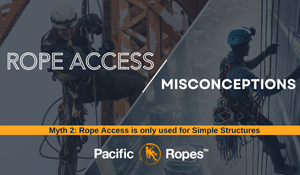What exactly is Rope Access?
We get asked this question a lot! To put it simply, Rope Access is a two-rope system (a working line and back-up line) that a Rope Technician attaches to with a harness in order to complete some type of work at-height. Using additional gear, a Rope Access technician can maneuver themselves up, down, and across, while securing a variety of work positions. This system of mobility is what allows a Rope Access Technician to access difficult work locations with ease and what makes Rope Access a great solution to many project access challenges.
Part of the Rope Access methodology is the anchorage for rope placement. First, anchors must meet static strength requirements. And, the anchors must be independent- one for the working line and one for the back-up line, which together ensures a system of redundancy. How the ropes are rigged to the anchors can vary between locations but everything is pre-planned and recorded in the Work and Rescue plan, which we outlined in Part 1 of our Safety Series.
Part of the rigging procedure includes deciding which anchors to use, what angles the ropes are attached to the anchors, and how the ropes will be protected from external elements. When pre-planning the rigging procedure, redundancy is key to ensuring that the system is consistently safe.
Another aspect to the rigging procedure is what we call rigging for rescue. This means that the ropes are rigged with an exact rescue procedure in mind. Again, how this plays out differs from location to location but either a rescue haul bag is in place for deployment or the ropes are rigged in a way that the Supervisor can lower the injured party without deploying another Rope Tech. If need be, Rope Access techniques do enable rope teams to perform group rescues efficiently before Emergency personnel arrive. This is a major advantage in a rescue situation.
As mentioned above, a Rope Technician is attached to both a working line and a back-up line by their harness. As another aspect of redundancy, the attachments to both these ropes are independent of each other. So, in the unlikely event that the main line malfunctions, a Rope Access technician is attached to an identical secondary or back-up line to ensure their safety.
Once the anchor system is set, the ropes are rigged, the Rope Access Technician has checked their gear, and everyone has performed a buddy check, the team can now use the Rope Access techniques they’ve learned in training for access and work. What is important to understand is that all these techniques operate within the redundancy of the Rope Access method, which allows the whole Rope Access system to operate with absolute safety.
If the Rope Access method is used with absolute correctness, there should be zero accidents on site.
You can find more information on Rope Access safety statistics through IRATA here. IRATA makes is a priority to provide transparent reporting with any Rope Access incidents and reading through, you will find most incidents are caused by user error or external influences. When you decide to use Rope Access on your work site, you can be confident that the method is fool proof, fast, and above all else, safe.
Read more about Rope Access Safety here




